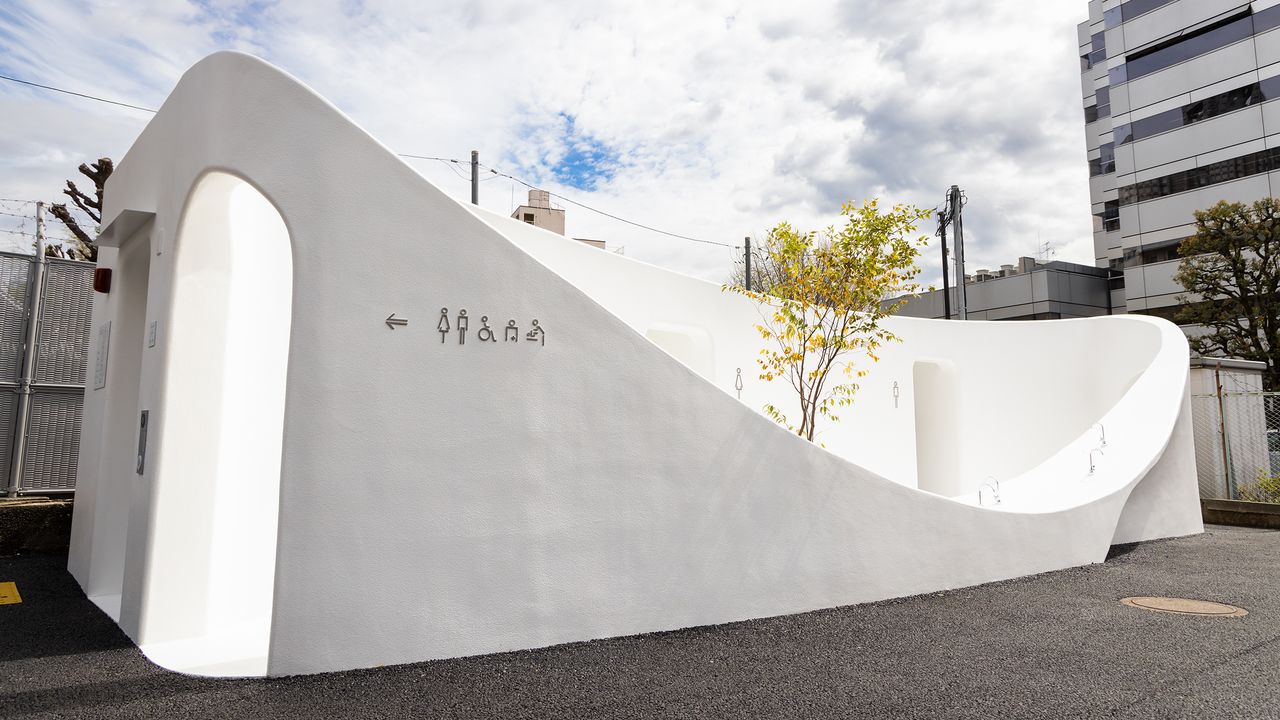
Tokyo Toilet Project: New Landmarks Arise in Shibuya
Guideto Japan
Lifestyle Design Architecture- English
- 日本語
- 简体字
- 繁體字
- Français
- Español
- العربية
- Русский
Bringing Creativity to Public Toilets
The Tokyo Toilet Project, an initiative by the Nippon Foundation in cooperation with the Shibuya municipal government, aims to change the perception that public toilets are smelly, dark, dirty, and dangerous by adopting innovative, imaginative designs for the facilities.
The Tokyo Toilet Project brought together 16 globally renowned creators in fields like architecture, design, and fashion to revamp 17 public restrooms in Shibuya. The last of these, the Nishisandō Public Toilet, opened on March 24 of this year. The facility was designed by Fujimoto Sou, design producer of the 2025 Osaka Kansai World Expo site.
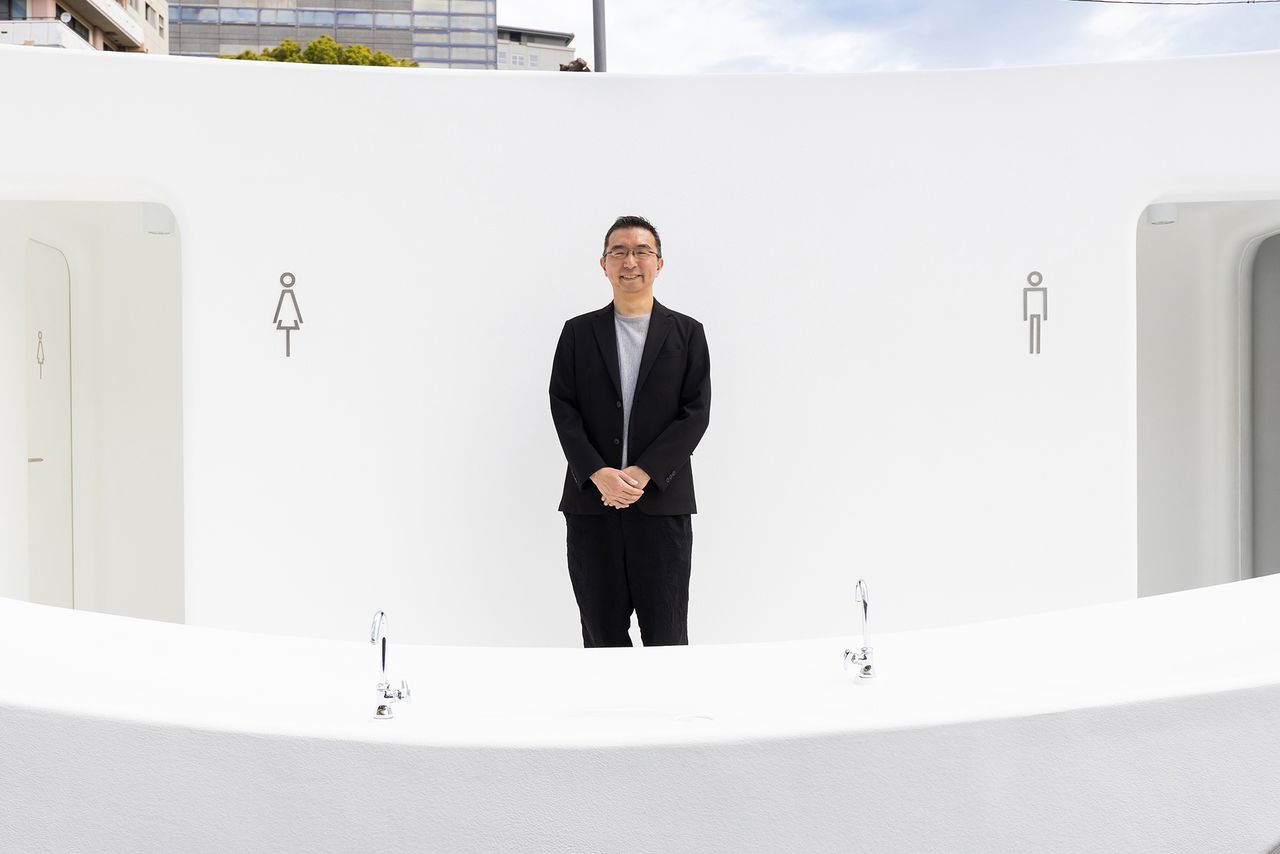
Architect Fujimoto Sou outside the Nishisandō Public Toilet. The public restroom was designed based on the concepts of “water source” and “container.”
The project’s first two toilets, designed by architect Ban Shigeru and featuring transparent glass walls, created a stir around the world when they were unveiled in August 2020. Fully transparent when unoccupied, the glass of the two public restrooms turn opaque when the doors are locked. The see-through design allows users to check if the interior is clean and offers reassurance that they are unoccupied.
Another to garner international attention is the Nanagō Dōri Park Toilet, which opened in August 2021. This contactless toilet by Satō Kazoo and the award-winning Disruption Lab Team is featured in an upcoming film on the Tokyo Toilet Project by German film director Wim Wenders.
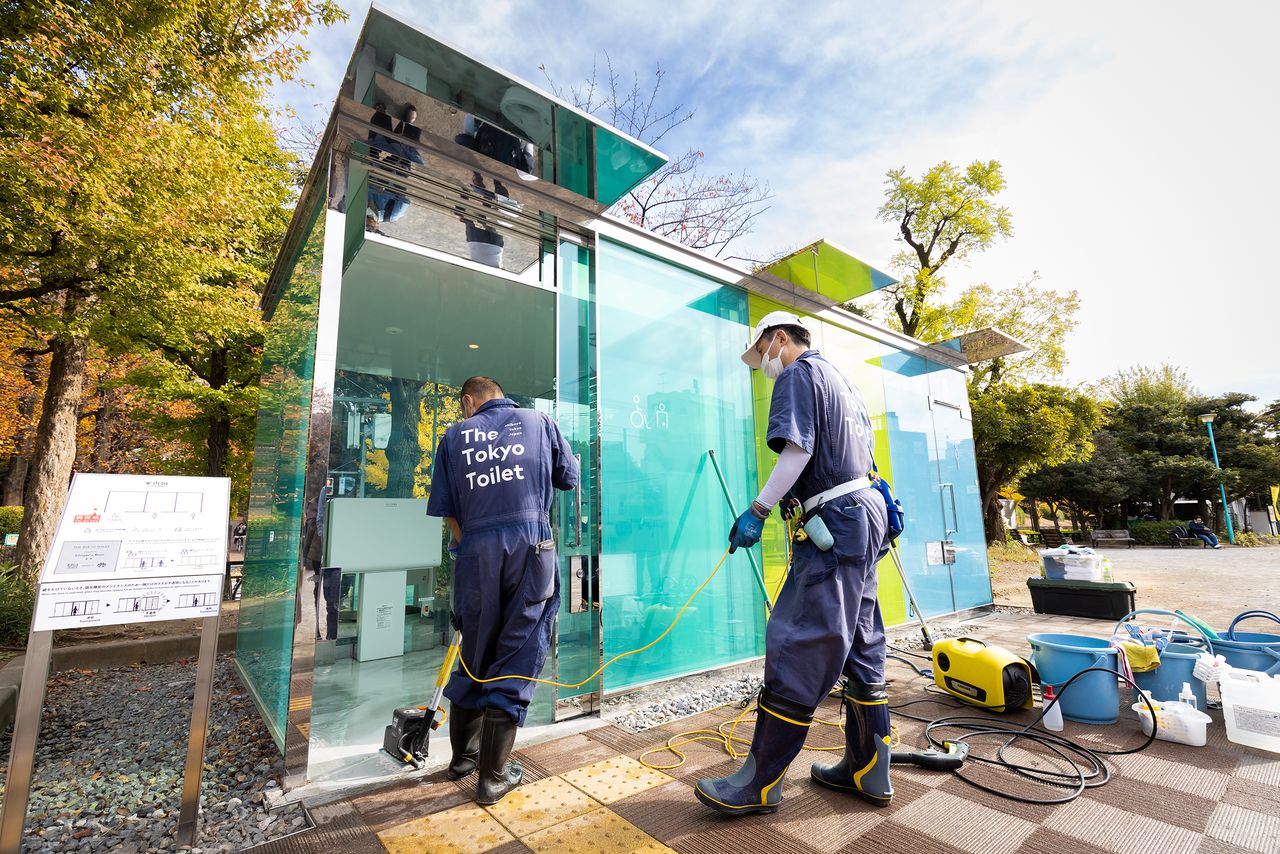
Ban Shigeru’s see-through toilet, at Haru-no-Ogawa Community Park undergoing cleaning.
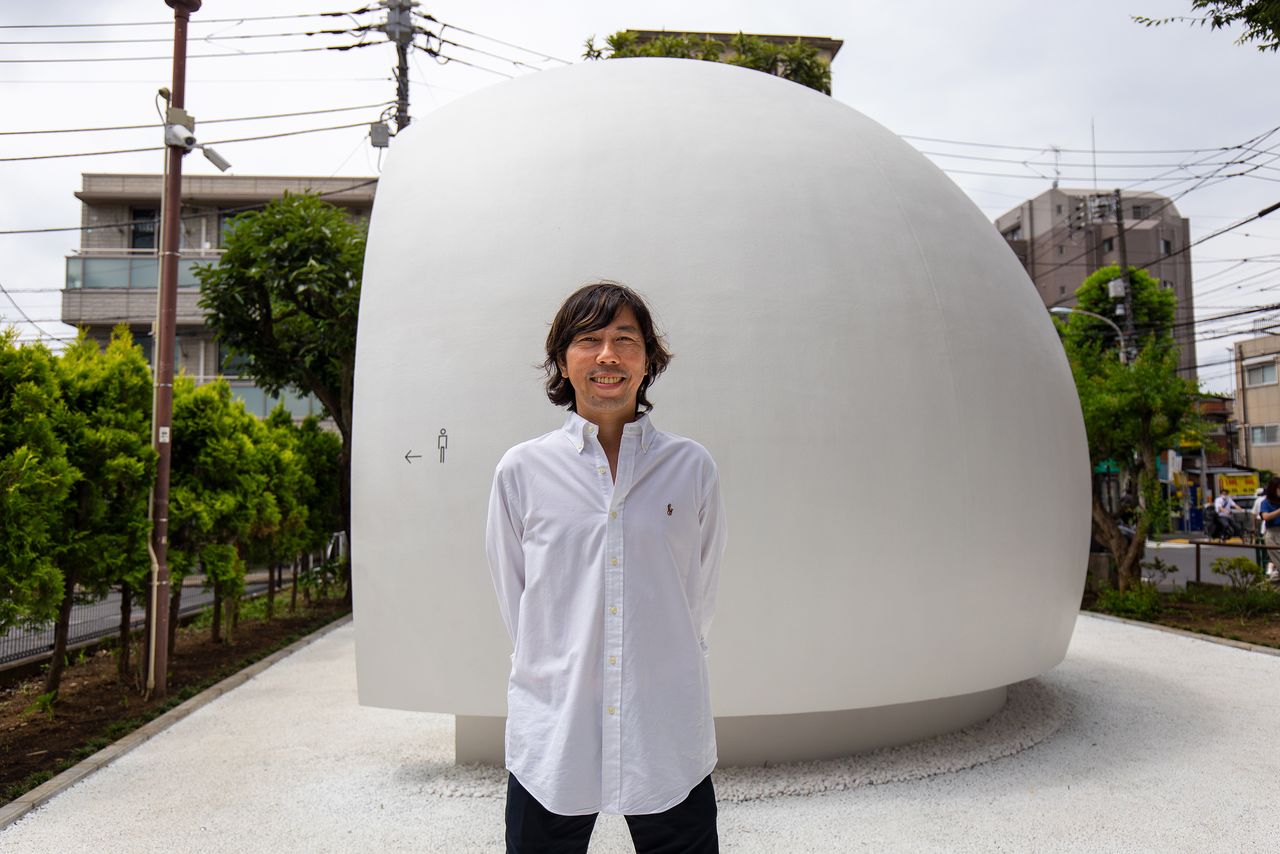
The “Hi Toilet” in Nanagō Dōri Park and creator Satō Kazoo. The facility won gold at the 2022 iF Design Award, one of the world’s three major design awards.
Regular Maintenance Key to Upkeep
A striking feature of the project is that many of the buildings’ exteriors are pure white. Fujimoto explains that white has high visibility and projects cleanliness, shining like a light in dull urban surroundings. He admits that it does show dirt easily, though, and is not usually the first choice of color for public toilets. But since the project also emphasizes maintenance, few restrictions were placed on the creators, who had mostly free rein for their ideas.
The project’s toilets are cleaned three times a day and undergo deep cleaning using solvents and other specially designed cleansers once a month. Exterior surfaces, lighting, and ventilation undergo maintenance once a year. Painstaking maintenance ensures that the toilets remain pleasant to use and keeps the white walls and floors, glass enclosures, natural wood, and other design elements in tip-top condition.
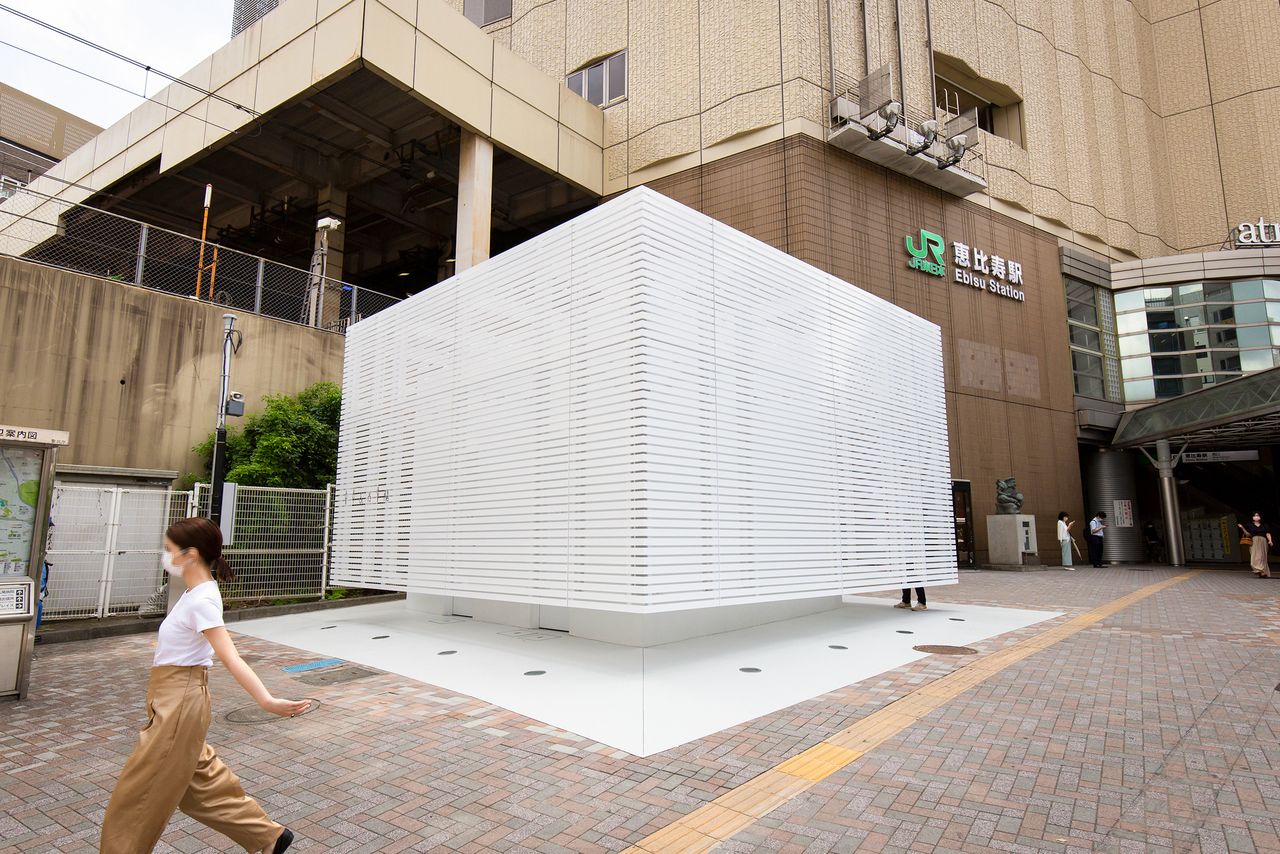
The Ebisu Station West Exit Public Toilet, nicknamed “White” for the images of cleanliness and peace of mind it evokes, was designed by Satō Kashiwa.
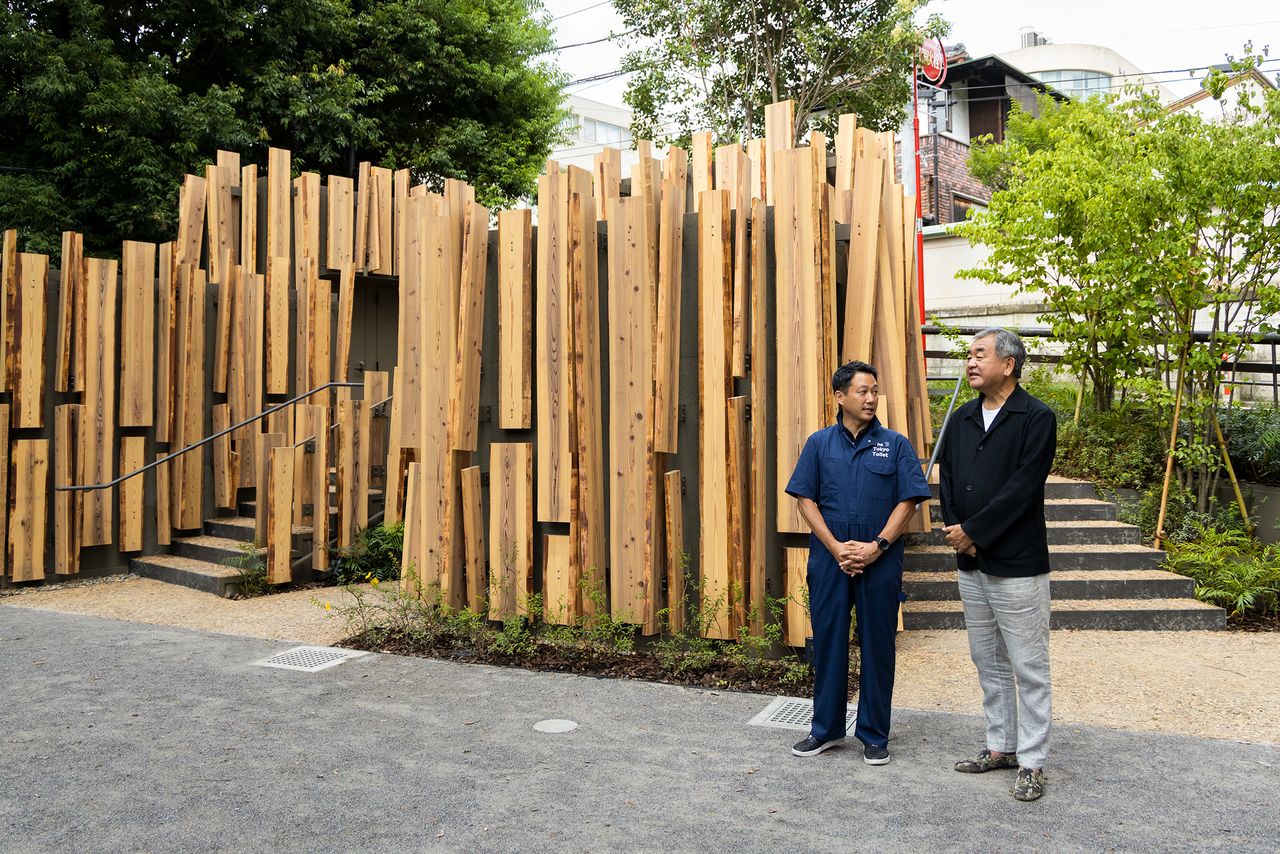
The cedar-clad exterior of the Nabeshima Shōtō Park Toilet, designed by Kuma Kengo, requires diligent maintenance. Kuma (right) is seen here with Sasakawa Junpei, executive director of the Nippon Foundation.
At the start of the project, Nippon Foundation Executive Director Sasakawa Junpei asserted that getting the toilets built was only half the project, saying that it will be just as important for the facilities to be used and maintained. He noted that only by keeping the restrooms in pristine condition will the project’s true worth become apparent.
Many architecture fans and art lovers visit Shibuya to observe the public toilets, and the municipal government is keen to turn the structures into a tourism asset. The Shibuya City Tourism Association hosted its first Tokyo Toilet bus tour in November 2022. Participants visited the various facilities and saw how they are cleaned. The tour, which included a social gathering, proved popular, and the association plans to hold additional outings at regular intervals.
The project also organizes children’s cleaning crews, with the aim of instilling in young participants the importance of maintaining public facilities. In its role as a Tokyo cultural center, Shibuya aims to accommodate people of all ages, genders, and physical abilities to support diversity.
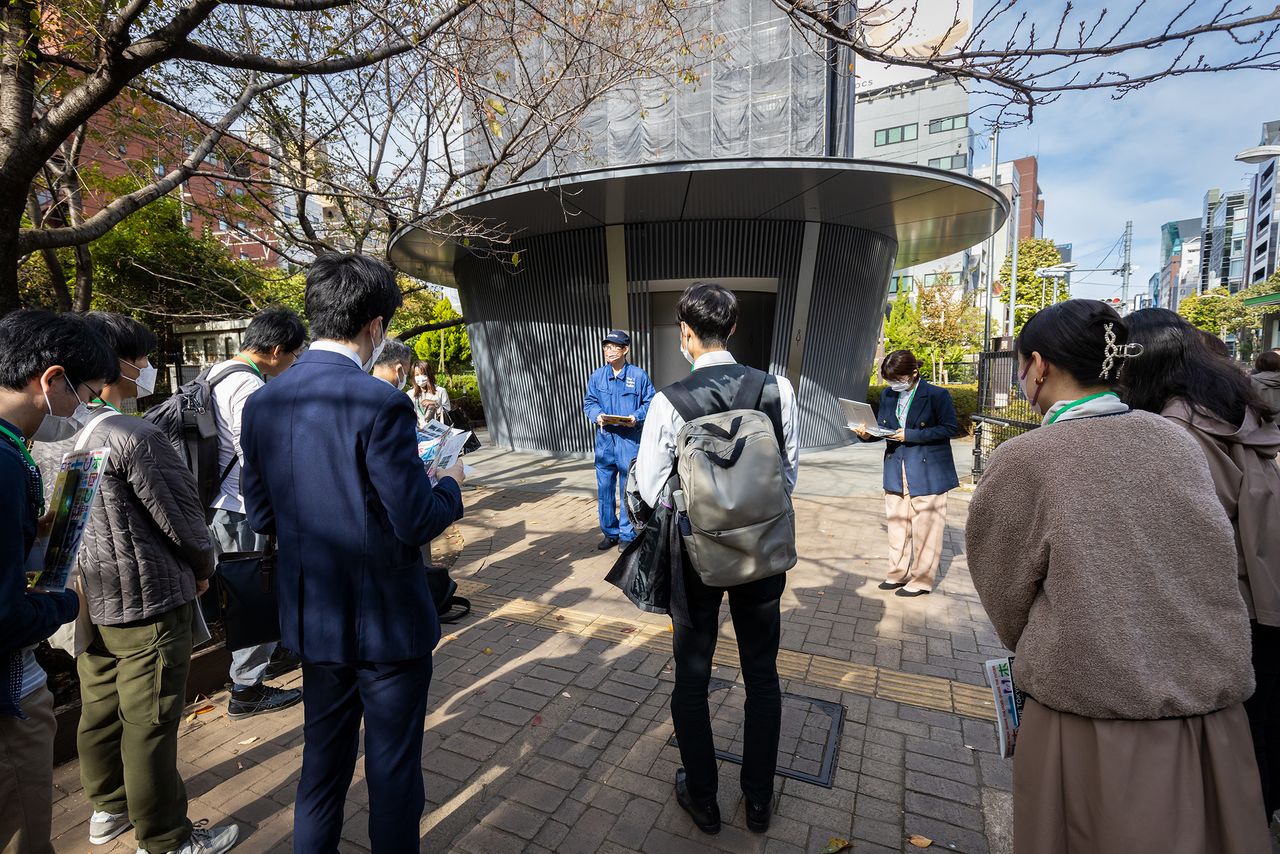
The first organized bus tour started at the Jingū-dōri Park toilet, designed by Andō Tadao.
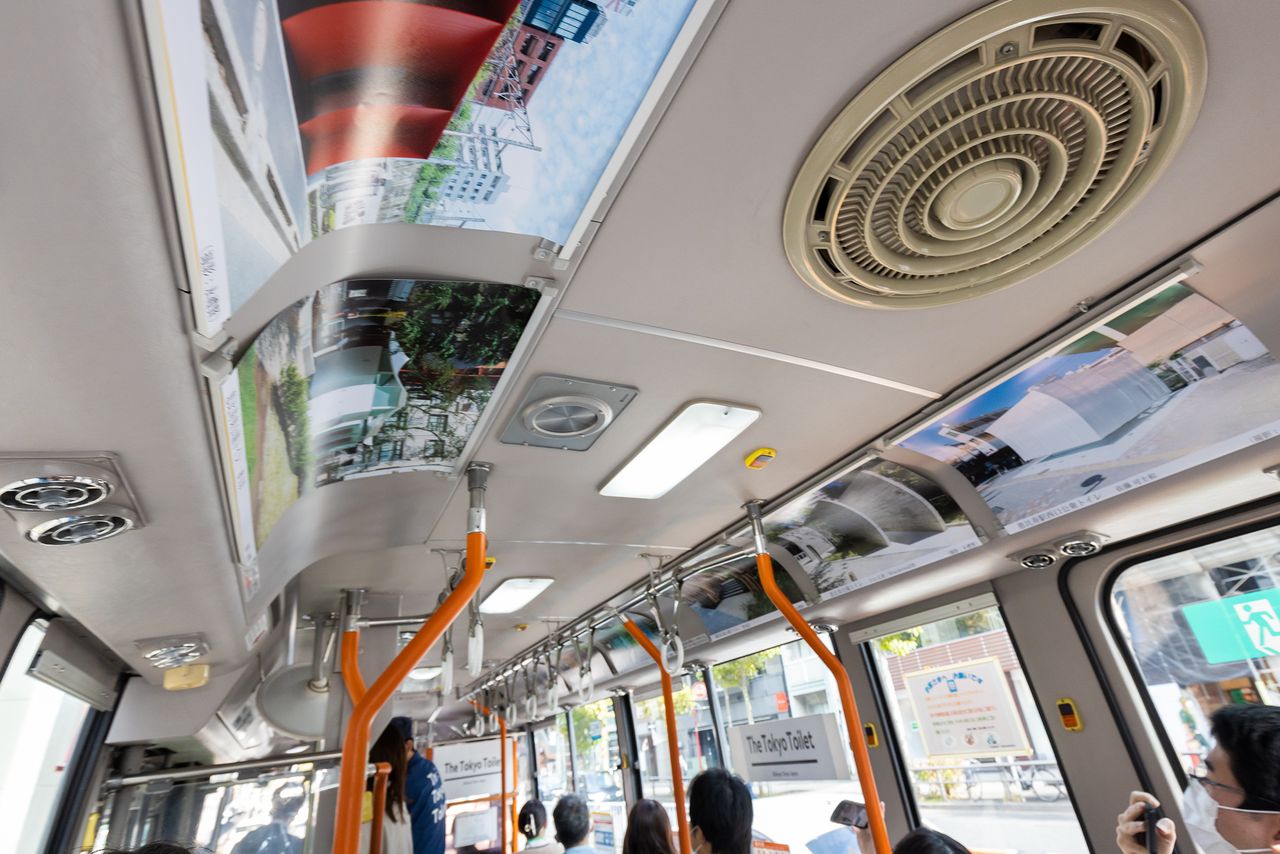
Photos of the creators’ works were displayed inside the tour bus.
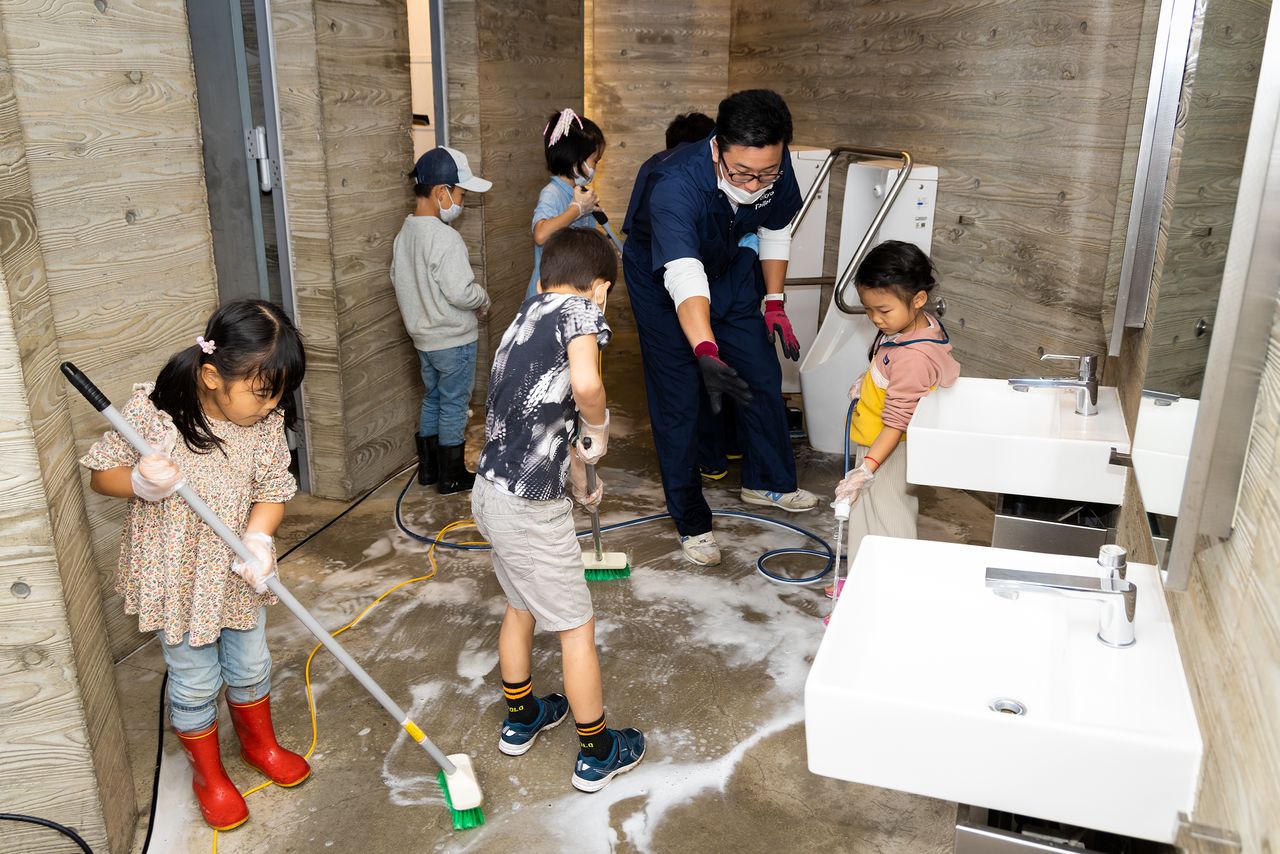
Children scrub the floor at the Ebisu Park Toilet in October 2022.
Related article › The Tokyo Toilet Project: Top Creators Cast Public Restrooms in a New Light
Related article › Tokyo Toilet Project: More Public Restrooms Designed by Top Creators Pop Up in Shibuya
■Mark Newson
Urasandō Public Toilet (Sendagaya 4-28-1)
This plain concrete structure, nestled under the Tokyo Metropolitan Expressway near Meiji-dōri’s Kitasandō intersection, opened on January 20, 2023. Elements such as the structure’s copper roof, similar to those used for shrines and temples, and the approach with stacked stone walls project an air of traditional Japanese architecture. This facility is the creation of Australian Mark Newson, a contemporary product designer noted for works for brands like Louis Vuitton and Apple.
Inside, the blue-green walls evoke cleanliness. As the years go by, the building’s copper roof will develop a verdigris patina. This is one toilet that architecture fans will want to visit again and again to examine how the interior and exterior colors gradually meld in harmony.
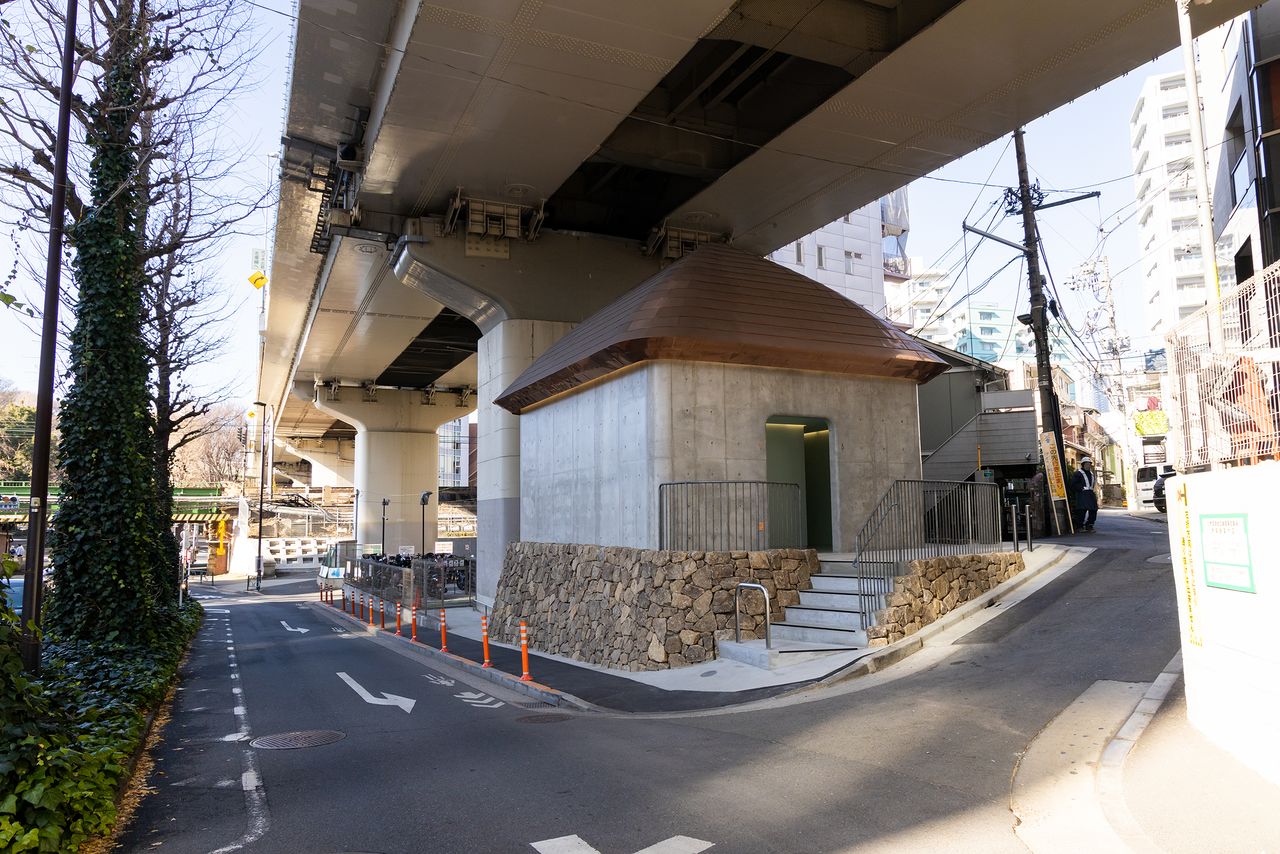
The Urasandō Public Toilet is close to the Yoyogi entrance to Meiji Jingū.
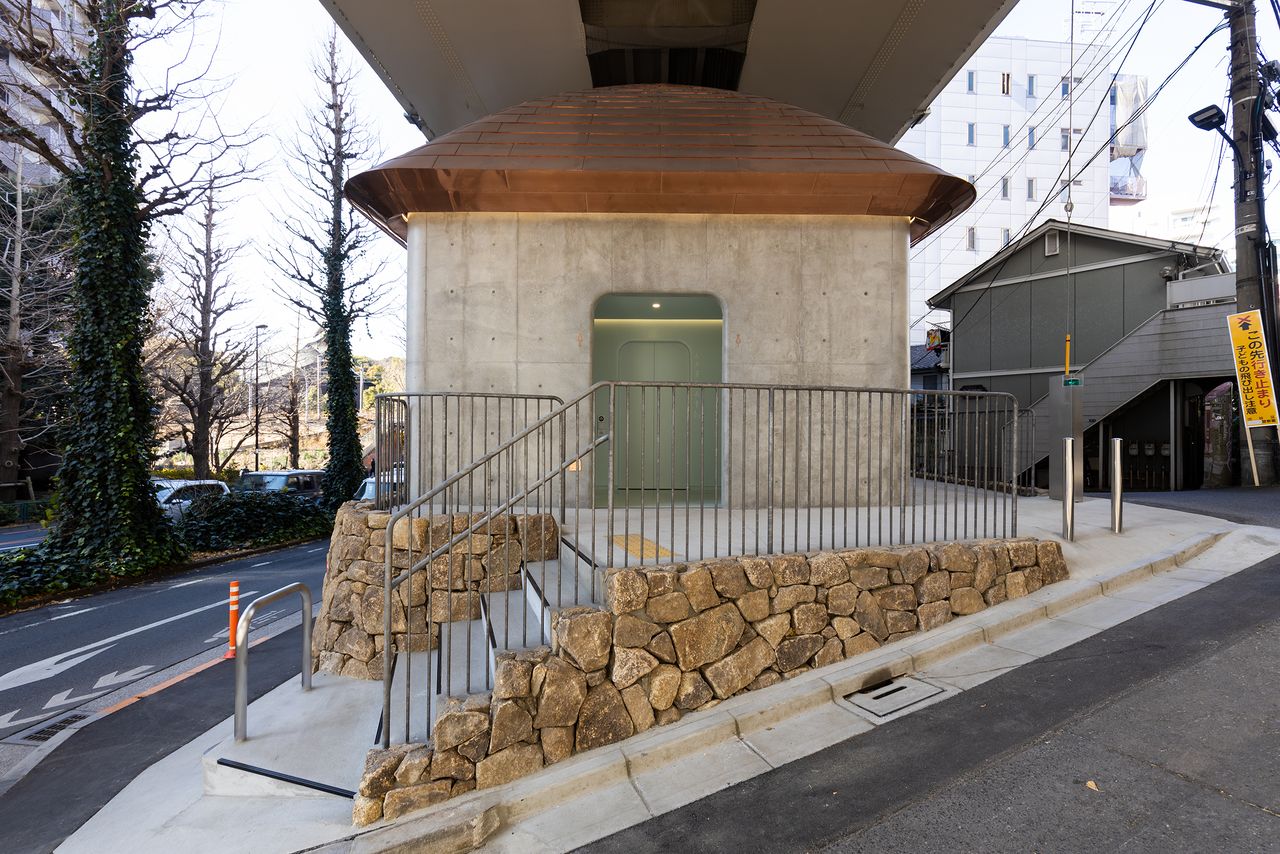
The building’s design is distinguished by a stacked stone wall and a gently curved copper roof echoing a traditional Japanese roofline.
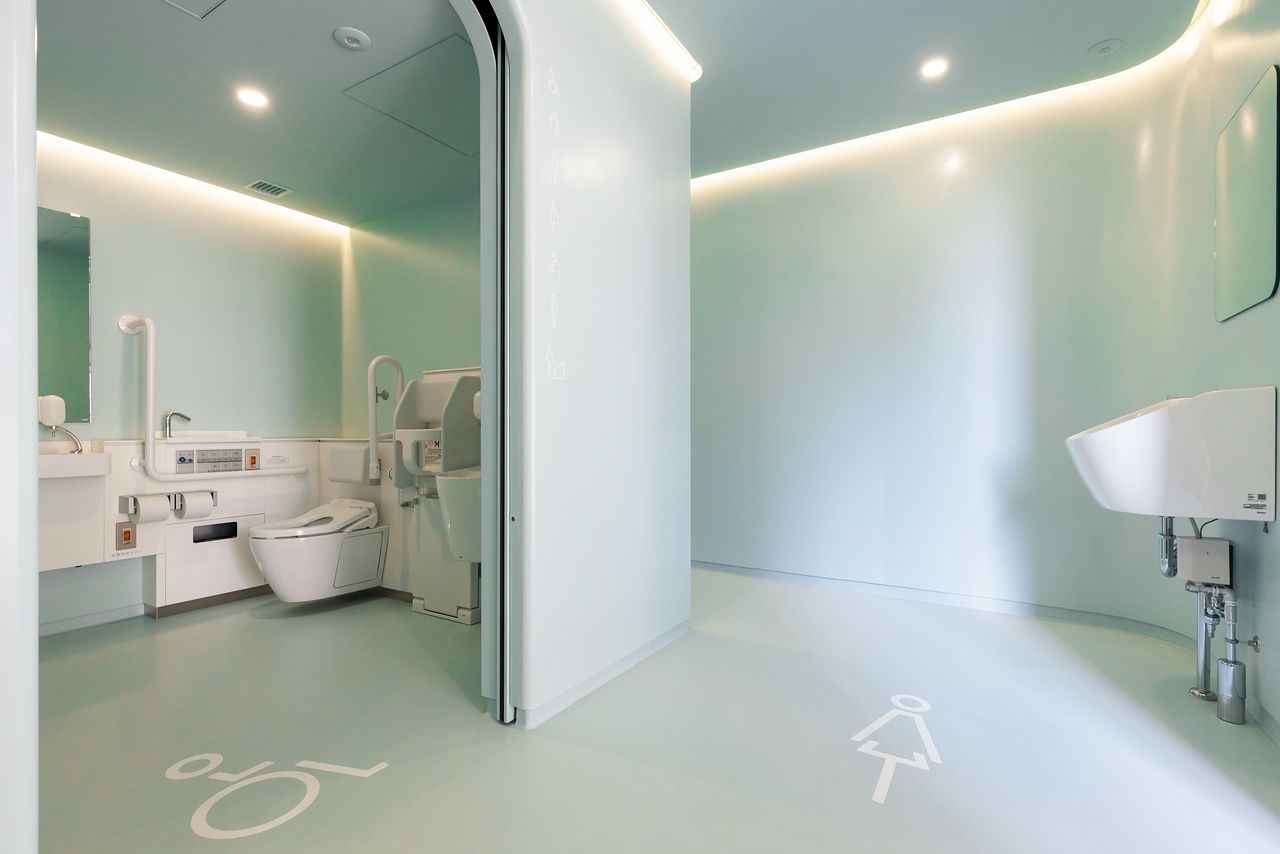
The soft green interior and cutting-edge facilities promise cleanliness and comfort.
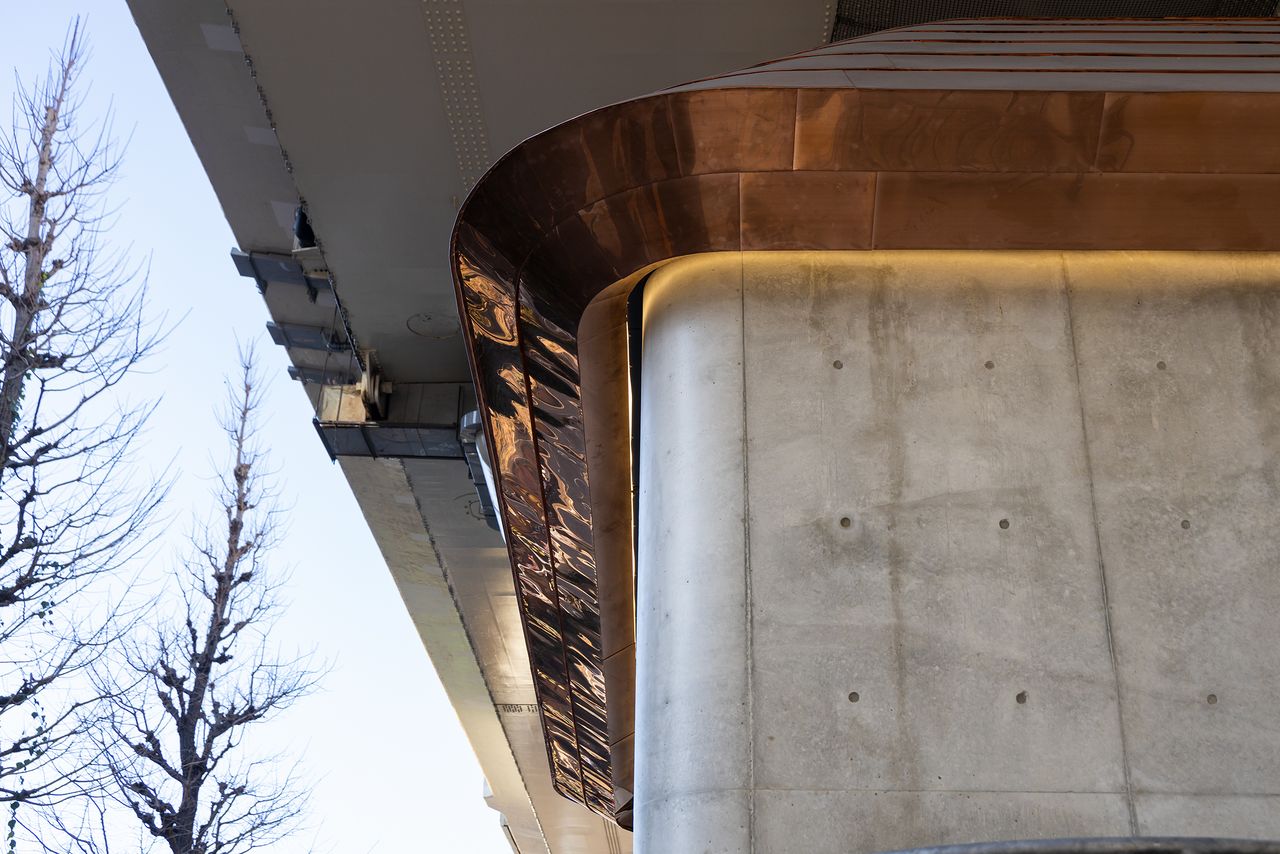
The building may project a different feel once the roof develops a verdigris patina, harmonizing with the green tone of the interior.
■Miles Pennington and UTokyo DLX Design Lab
Hatagaya Public Toilet (Hatagaya 3-37-8)
The Hatagaya Public Toilet, opened on February 22, 2023, aims to function both as a restroom and a community meeting spot. The concept of “With Toilet,” the brainchild of Miles Pennington and the UTokyo DLX Design Lab, includes a space that can function as a meeting place, exhibition space, or even a pop-up shop.
The structure’s white walls are ideal for displaying art or serving as a screen for projected images. The 31 sunken bollards at the front can be pulled up, transforming into handy benches with the addition of planks for that purpose that can be reconfigured into different layouts, such as lecture-style or in a circular arrangement.
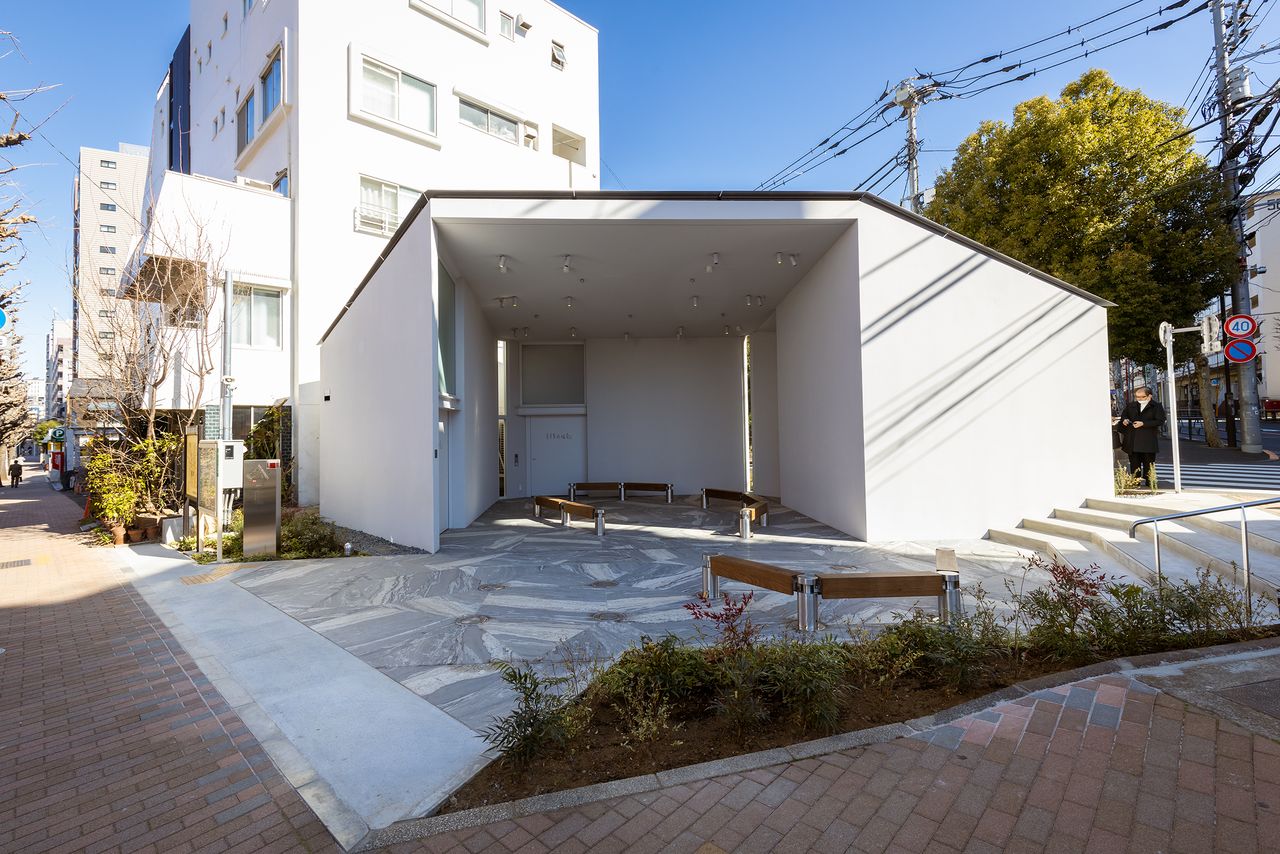
The Hatagaya Public Toilet stands near the intersection of Nakano-dōri and Suidō-dōro, an area with heavy pedestrian traffic.
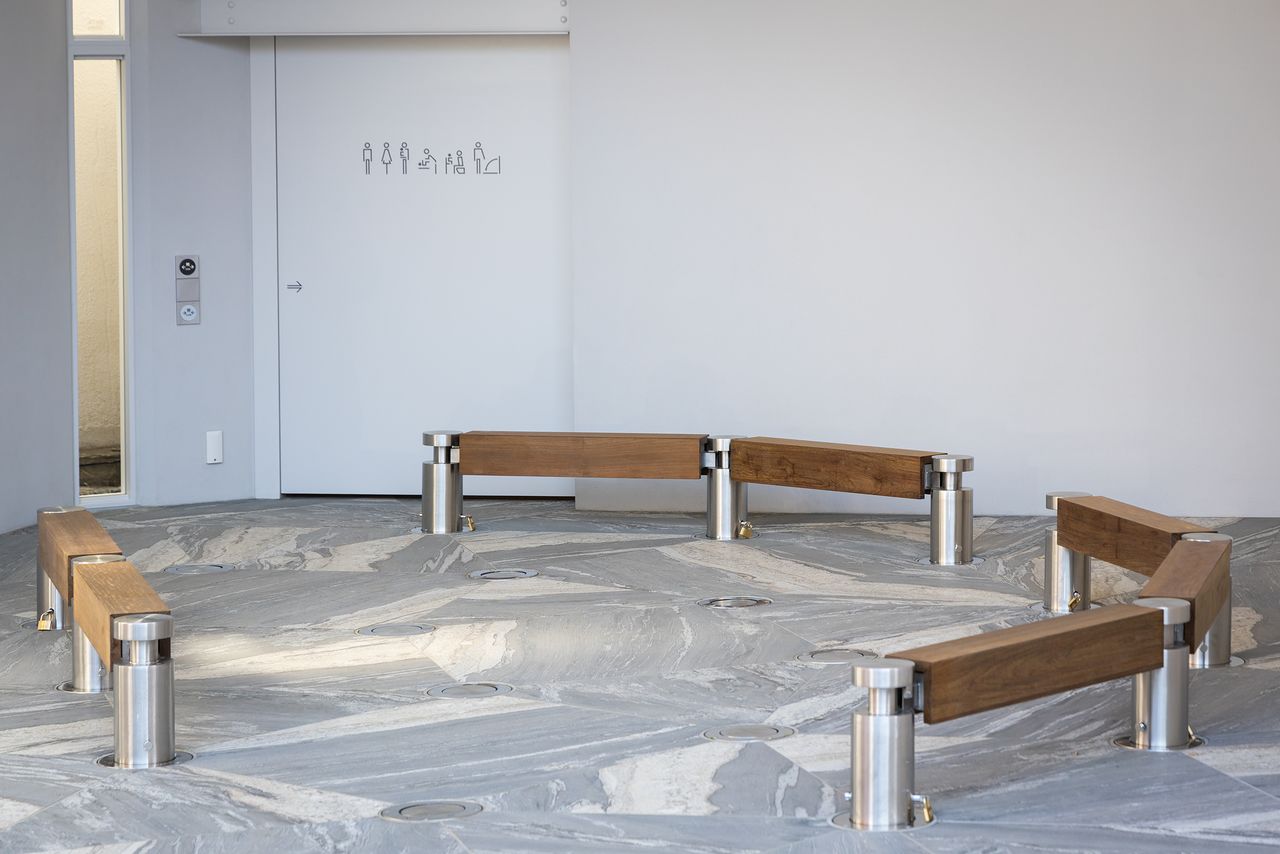
The benches using bollards as supports can be reconfigured as needed.
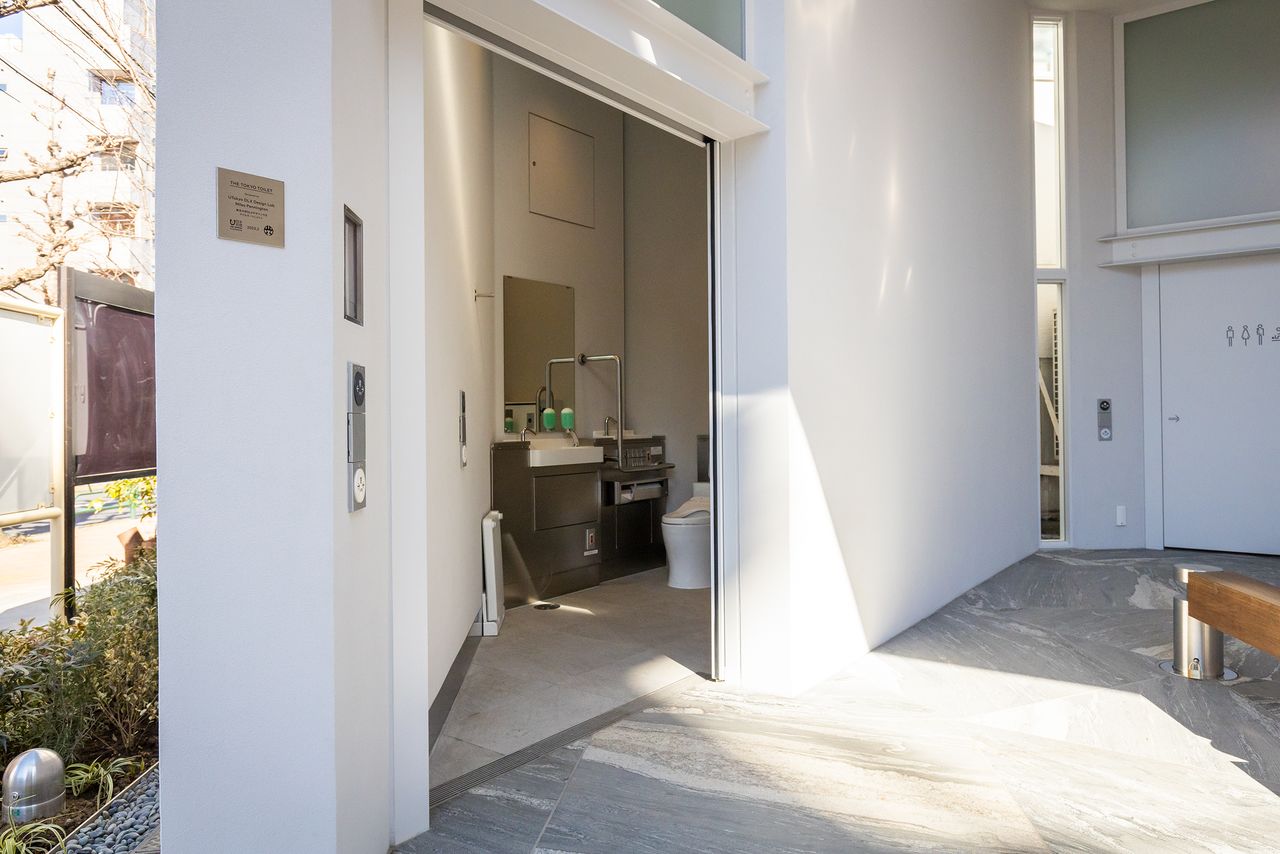
This toilet provides a full range of amenities, including facilities for ostomates, wall-mounted baby seats, and fold-down boards allowing users to remove footwear and stand on a clean surface when changing clothes inside a cubicle.
■Kobayashi Junko
Sasazuka Greenway Public Toilet (Sasazuka 1-29)
At first glance, the Sasazuka Greenway Public Toilet’s rusted exterior seems forbidding, but the structure, opened March 10, 2023, features a wide opening easily accessible to wheelchairs and baby buggies. Children’s toilets are near the entrance, allowing parents to easily keep an eye on their charges. The numerous apertures make the light-filled interior feel warm and safe, a feature that reflects the broad-ranging experience of Kobayashi Junko, head of the Japan Toilet Association and designer of over 250 public toilets.
The facility’s interesting design, consisting of cylinders of varying heights, is topped by a cheerful yellow canopy. The rusted steel cladding of the cylinders will change color with the passage of time, making this another destination design aficionados will want to visit time and again.
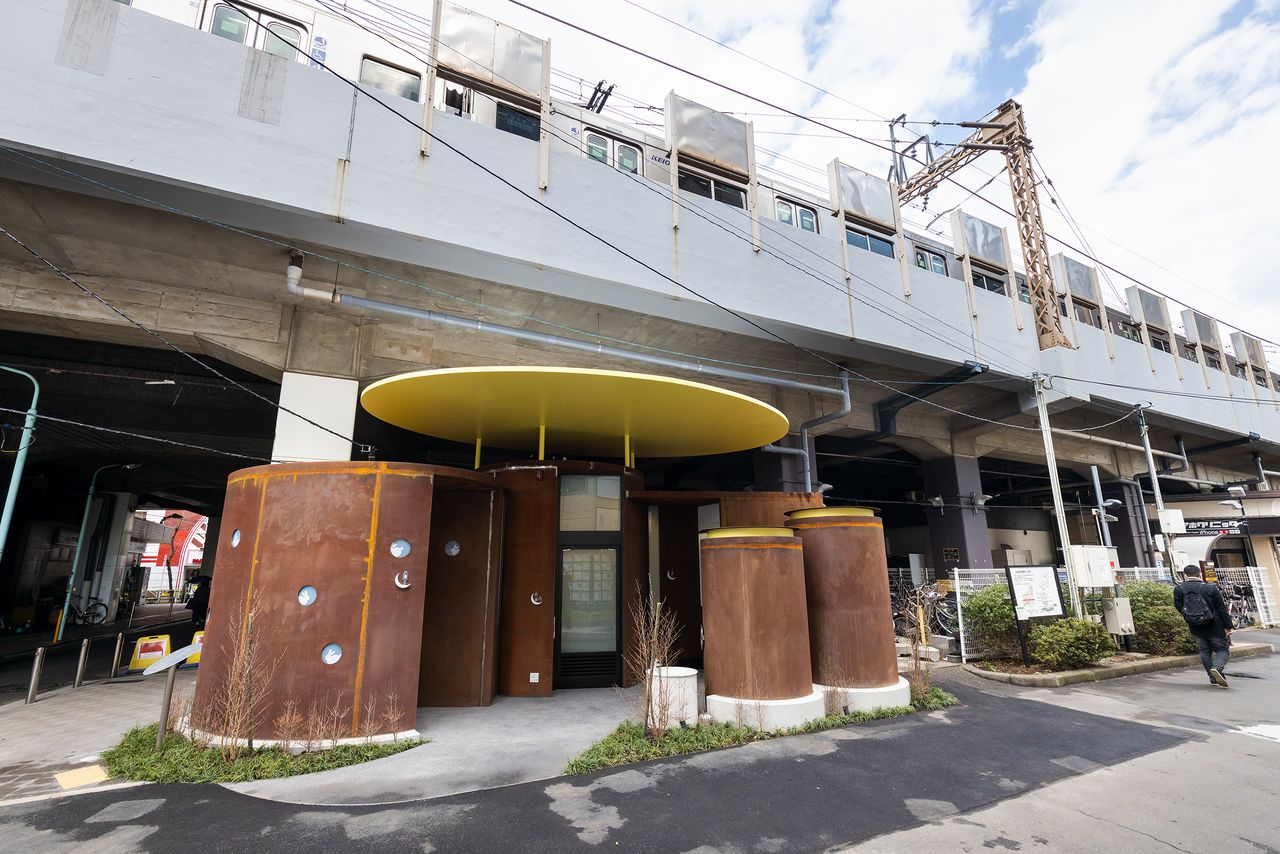
The Sasazuka Greenway Public Toilet under the Keiō Line railway tracks stands out with its rust-colored cylinders.
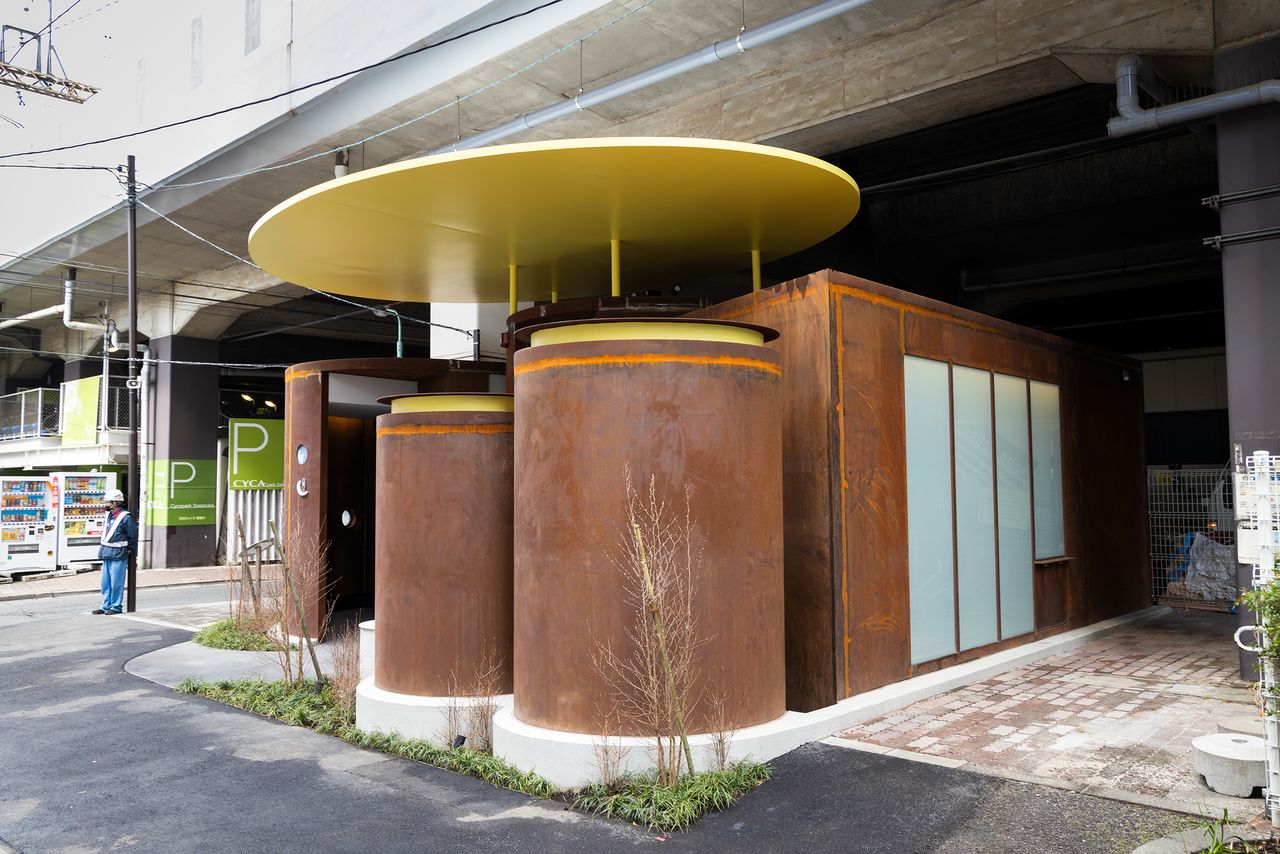
The glass-walled sides and back let in light, creating a bright interior and providing a sense of safety.
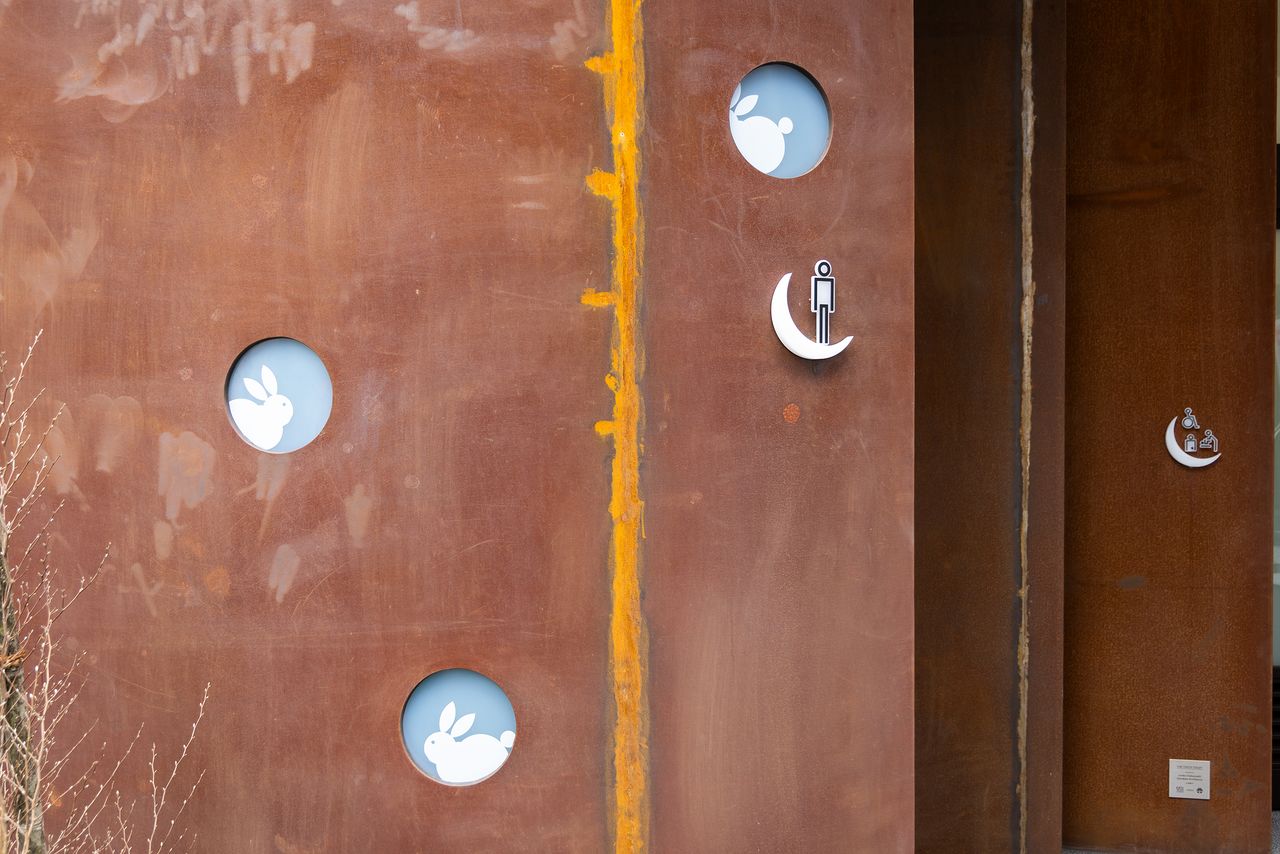
The walls depict rabbits and crescent moons, complimenting the yellow canopy reminiscent of a full moon.
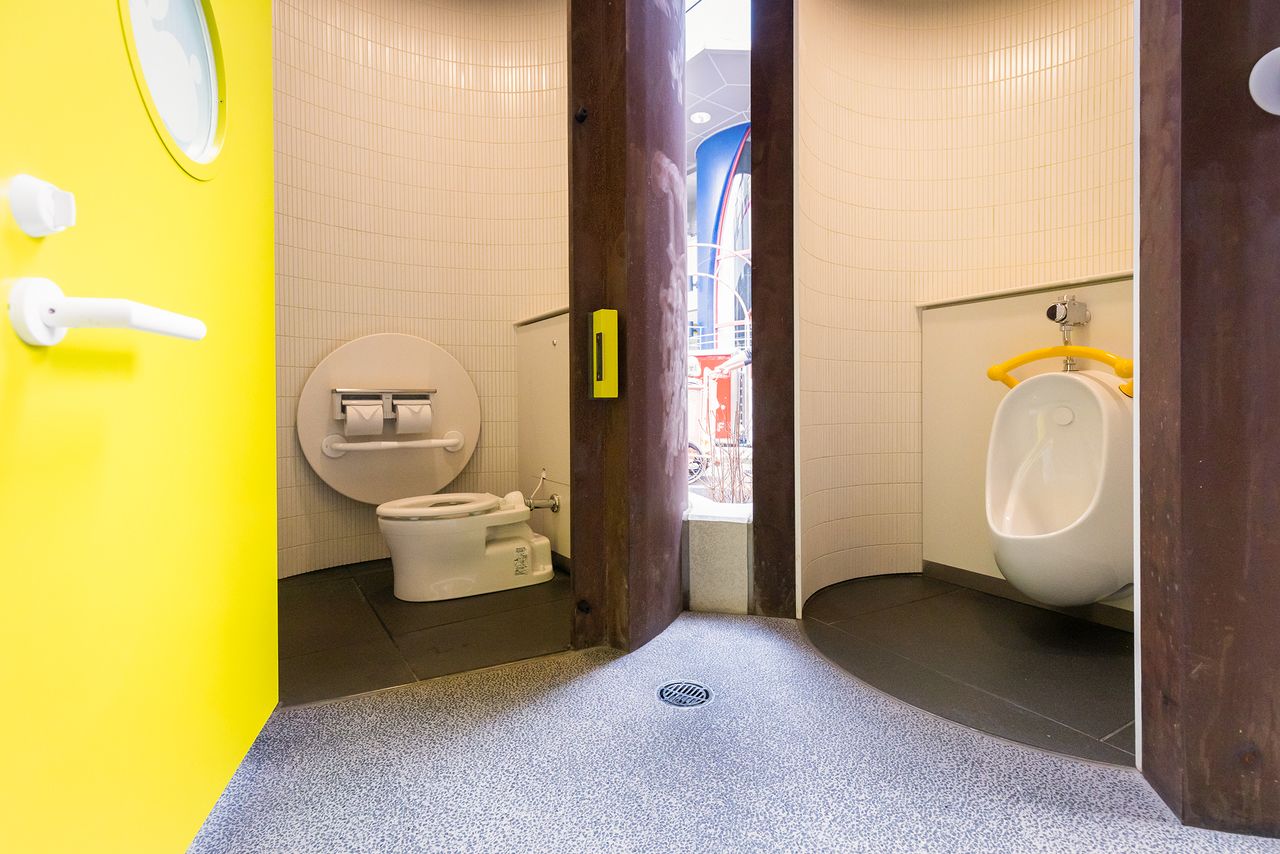
Two low cylinders near the entrance house a child-size toilet and urinal.
■Fujimoto Sou
Nishisandō Public Toilet (Yoyogi 3-27-1)
Designed by architect Fujimoto Sou, the Nishisandō Public Toilet opened on March 24, 2023. Fujimoto pictures public toilets as a shared space for freshening up and created this urban oasis modeled on the concepts of “container” and “water source.”
The washstand in the curved front of the structure can be used from both the passage inside the toilet and the sidewalk. Six faucets installed at differing heights serve the needs of any passerby, young or old, who want to wash their hands. To the side of the structure is an accessible toilet, ensuring all-round functionality.
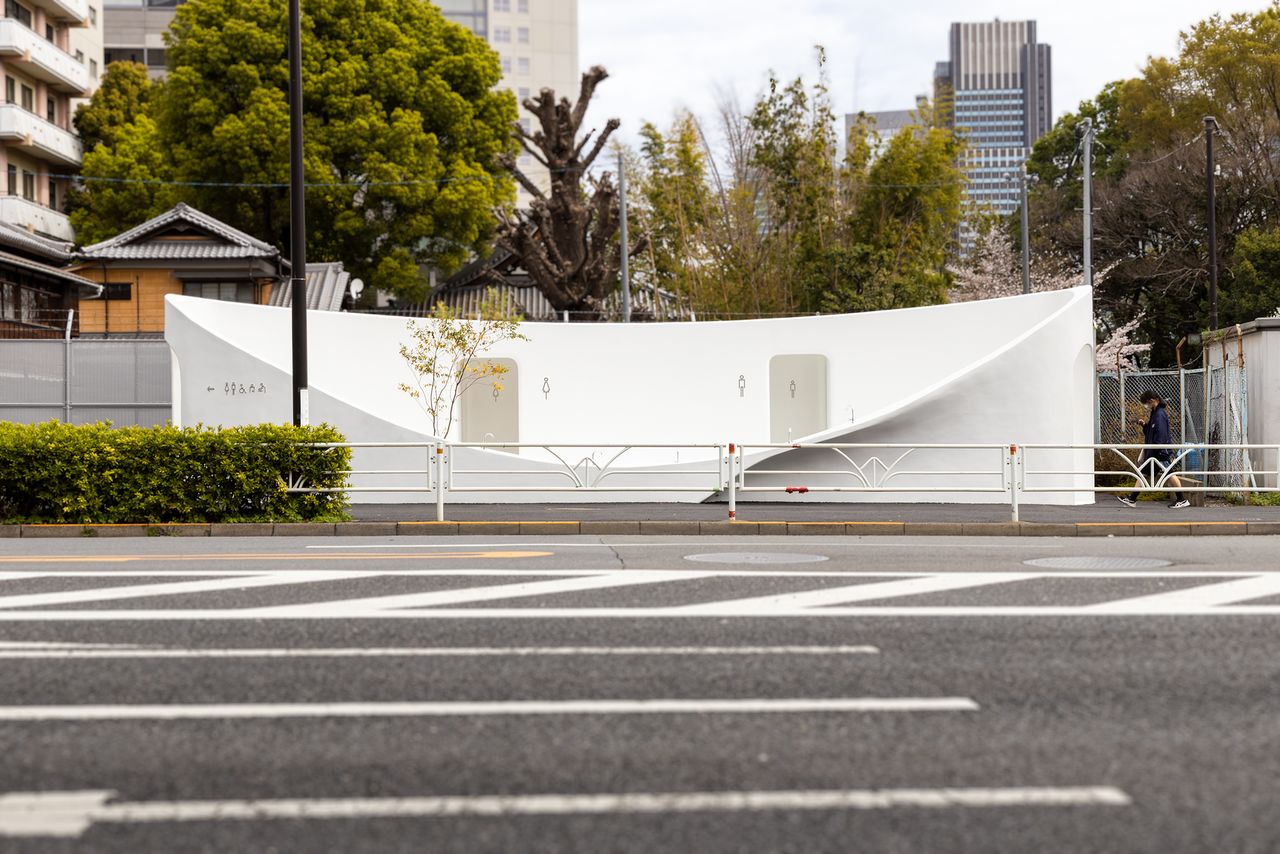
Seen from afar, the building resembles a container. A hainoki (Japanese sapphireberry) softens the stark exterior.
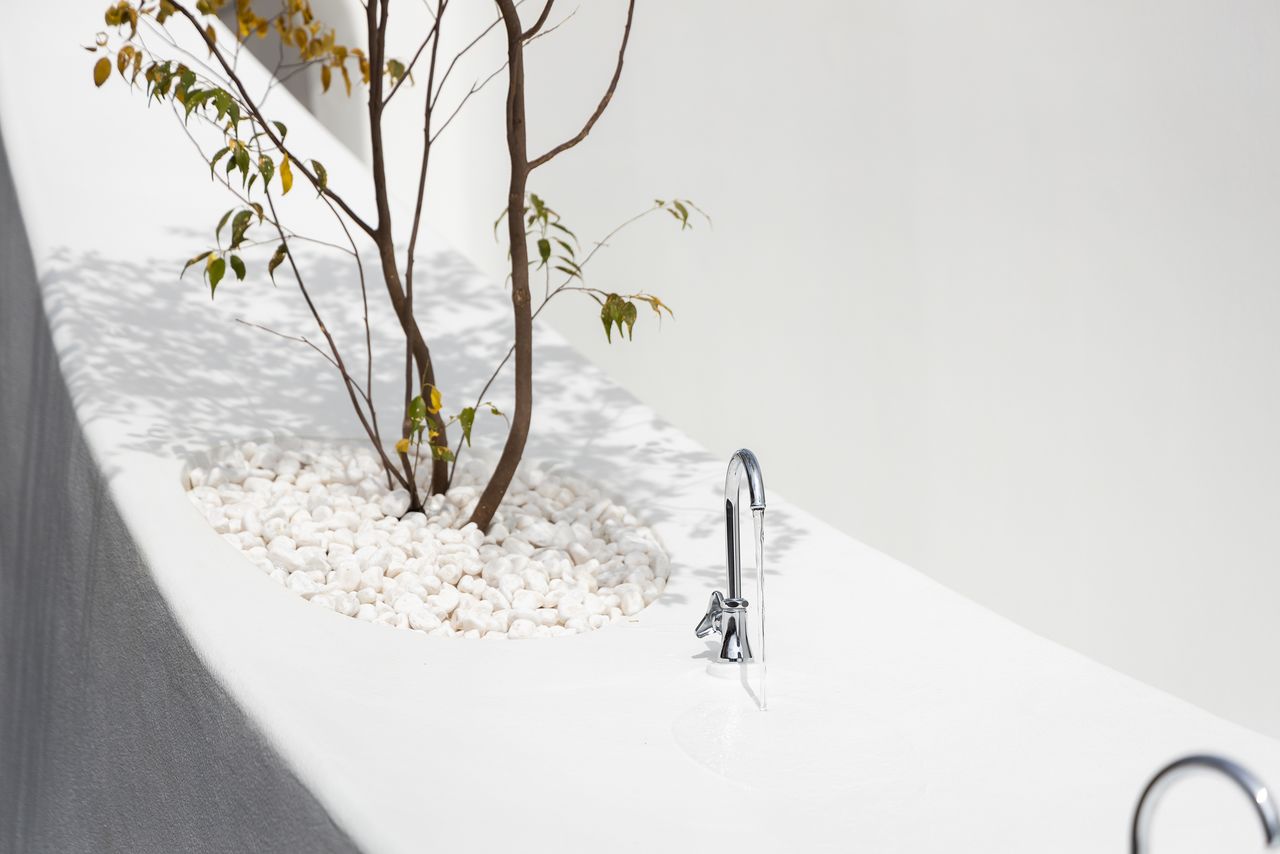
The washstand can be accessed from the sidewalk.
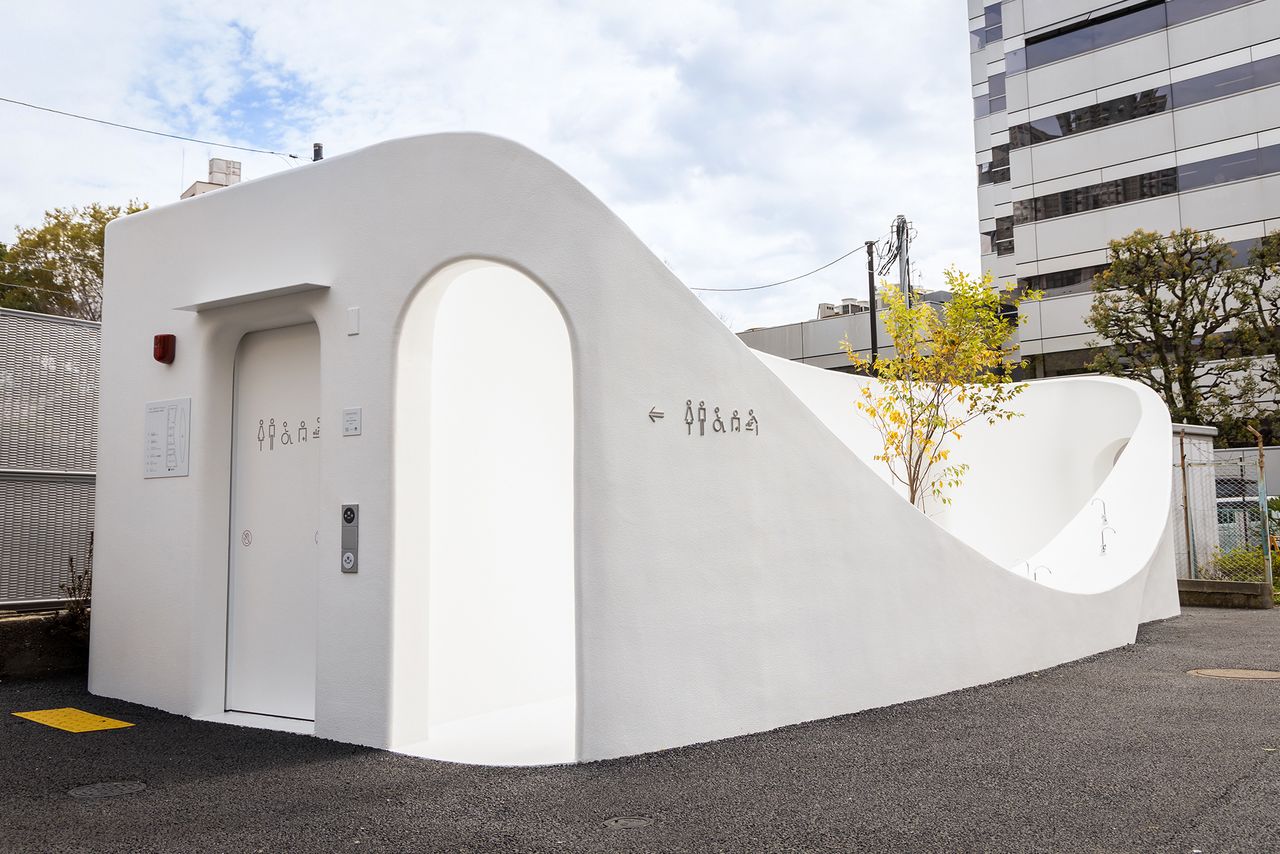
At the side is a toilet with facilities for everyone, from parents with babies to people with special needs.
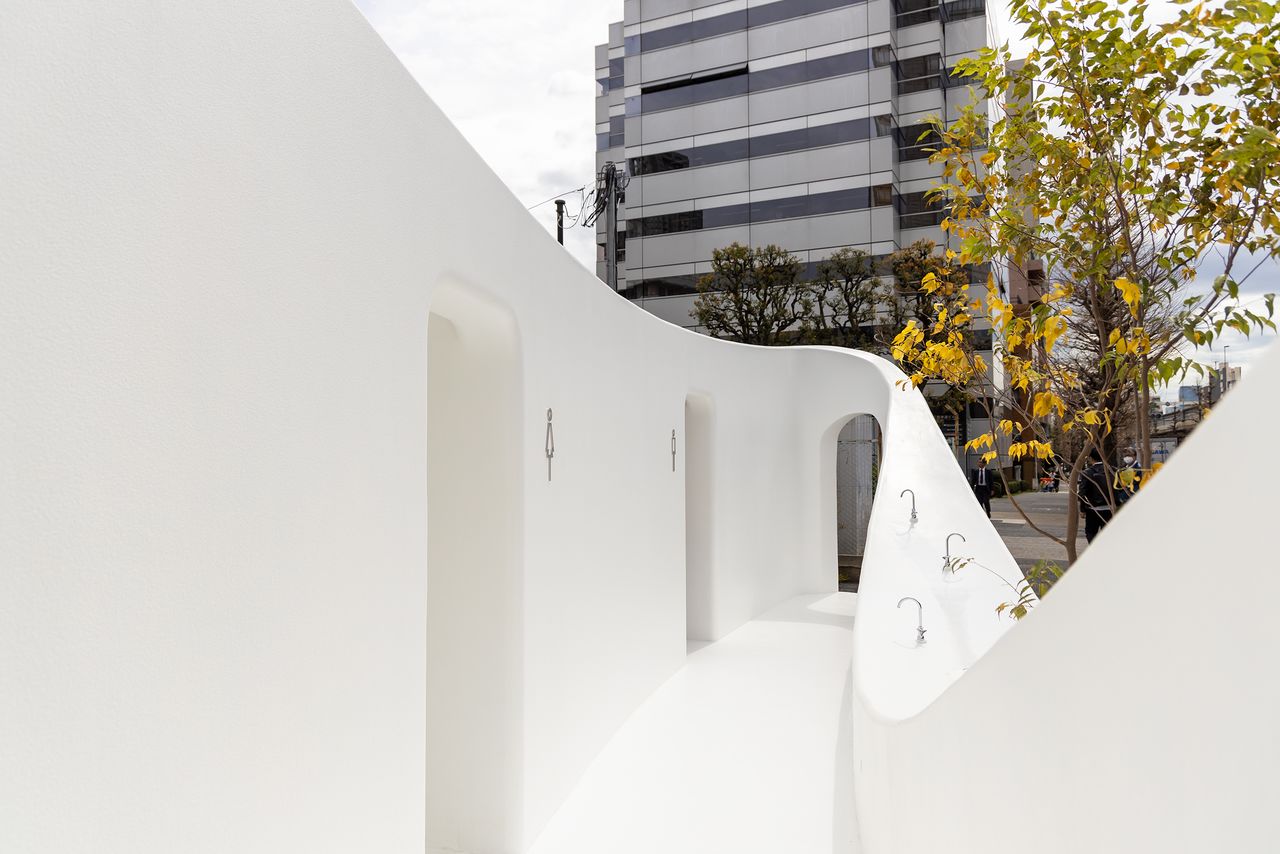
The curved passageway is an open corridor, promoting a sense of safety.
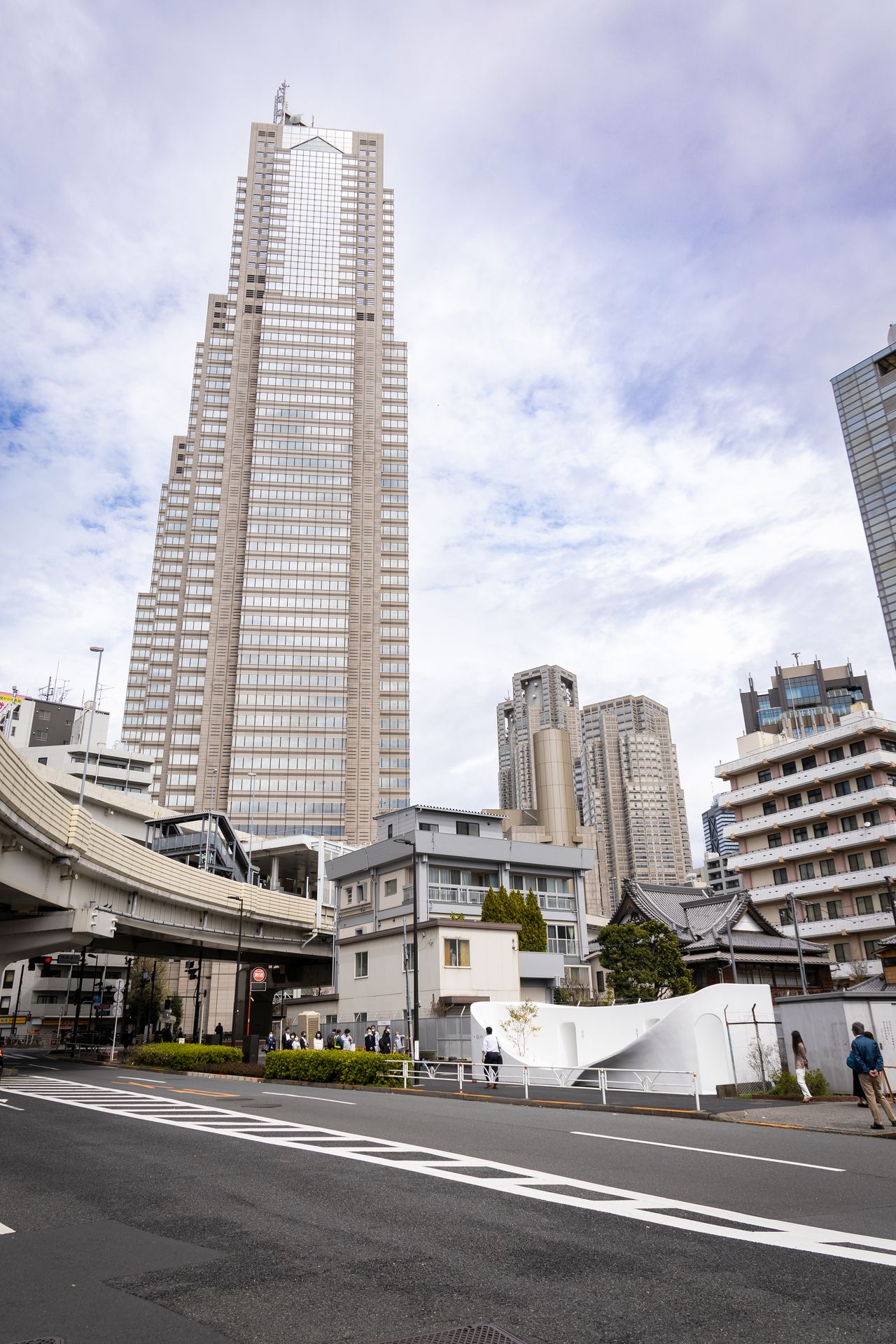
The pure white structure stands out in the urban grayness. In the background are the Park Hyatt Tokyo hotel and the Tokyo Metropolitan Government office towers.
(Originally published in Japanese. Reporting, text, and photos by Nippon.com.)